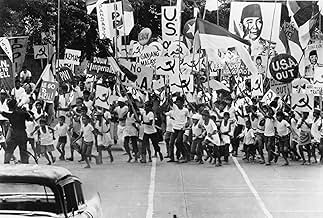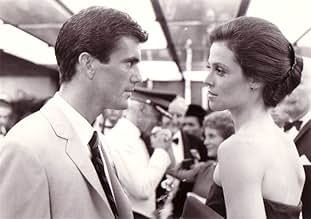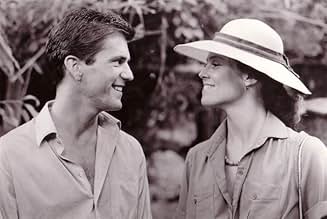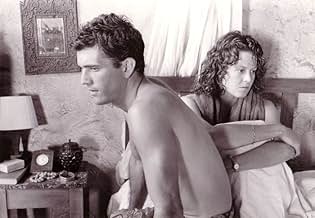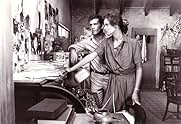एक युवा ऑस्ट्रेलियाई रिपोर्टर ने राष्ट्रपति सुकर्णो के शासन के दौरान इंडोनेशिया के राजनीतिक उथल-पुथल को नेविगेट करने की कोशिश की, जिसमें एक कम उम्र के फोटोग्राफर की मदद ली गई.एक युवा ऑस्ट्रेलियाई रिपोर्टर ने राष्ट्रपति सुकर्णो के शासन के दौरान इंडोनेशिया के राजनीतिक उथल-पुथल को नेविगेट करने की कोशिश की, जिसमें एक कम उम्र के फोटोग्राफर की मदद ली गई.एक युवा ऑस्ट्रेलियाई रिपोर्टर ने राष्ट्रपति सुकर्णो के शासन के दौरान इंडोनेशिया के राजनीतिक उथल-पुथल को नेविगेट करने की कोशिश की, जिसमें एक कम उम्र के फोटोग्राफर की मदद ली गई.
- 1 ऑस्कर जीते
- 10 जीत और कुल 14 नामांकन
कहानी
क्या आपको पता है
- ट्रिवियाDirector Peter Weir cast Linda Hunt in the role of Billy Kwan after failing to find an actor who could play the part the way he wanted.
- गूफ़Billy's still camera is a Nikon F2 Photomic, which was not released until 1971, while the film takes place in 1965.
- भाव
Billy Kwan: What then must we do? We must give with love to whoever God has placed in our path.
- कनेक्शनFeatured in Peter Weir Industry Seminar 1989 (1989)
- साउंडट्रैकBeim Schlafengehen
from "Four Last Songs"
by Richard Strauss
Performed by Kiri Te Kanawa and London Symphony Orchestra
Conducted by Andrew Davis
Courtesy of CBS Masterworks
Published by Boosey-Hawkes
फीचर्ड रिव्यू
Peter Weir's movie, set in Sukarno's Indonesia in 1965, can be seen as four films in one. The first is socio-political, focusing on the plight of the impoverished Indonesian people, the impending insurrection by the communist movement, and the bloody, chaotic aftermath of the coup. The second, coloured in Graham Greene-ish tones, has a cast of western journalists and diplomats failing to make sense of what's happening around them, and falling back on sex, drink and cynicism. The third - and most important in commercial-cinema terms - is a convincingly acted romance between rookie foreign correspondent Guy Hamilton (Mel Gibson) and British diplomat Jill Bryant (Sigourney Weaver), culminating in an unlikely and sentimental ending to the film.
But it is the fourth of these "sub-movies" which is the most intriguing; this concerns the diminutive and enigmatic Australian/Chinese photographer Billy Kwan, an astonishing - and Oscar winning - portrayal by actress Linda Hunt. Billy sees himself as a puppet-master, pulling the strings of friends and colleagues, particularly of Jill and Guy, whom he throws together. But his need to take control also motivates him to help local people, not through indirect and political means, but directly like an early Christian, and this apparently benign course leads to tragedy. Billy is the true heart and conscience of this film.
Weir is not entirely successful in weaving these strands together, and leaves a few gaps in both plot and characterisation. He is also occasionally guilty of melodrama (a fault which, in the movie, Jill warns Guy about), especially in the film's closing scenes - though certainly not where he shows communist sympathisers being shot, which is factual. On the whole, however, the movie works on both commercial and artistic levels, and should be seen.
But it is the fourth of these "sub-movies" which is the most intriguing; this concerns the diminutive and enigmatic Australian/Chinese photographer Billy Kwan, an astonishing - and Oscar winning - portrayal by actress Linda Hunt. Billy sees himself as a puppet-master, pulling the strings of friends and colleagues, particularly of Jill and Guy, whom he throws together. But his need to take control also motivates him to help local people, not through indirect and political means, but directly like an early Christian, and this apparently benign course leads to tragedy. Billy is the true heart and conscience of this film.
Weir is not entirely successful in weaving these strands together, and leaves a few gaps in both plot and characterisation. He is also occasionally guilty of melodrama (a fault which, in the movie, Jill warns Guy about), especially in the film's closing scenes - though certainly not where he shows communist sympathisers being shot, which is factual. On the whole, however, the movie works on both commercial and artistic levels, and should be seen.
टॉप पसंद
रेटिंग देने के लिए साइन-इन करें और वैयक्तिकृत सुझावों के लिए वॉचलिस्ट करें
- How long is The Year of Living Dangerously?Alexa द्वारा संचालित
विवरण
- रिलीज़ की तारीख़
- कंट्री ऑफ़ ओरिजिन
- भाषाएं
- इस रूप में भी जाना जाता है
- Ein Jahr in der Hölle
- फ़िल्माने की जगहें
- उत्पादन कंपनियां
- IMDbPro पर और कंपनी क्रेडिट देखें
बॉक्स ऑफ़िस
- बजट
- $1,30,00,000(अनुमानित)
- US और कनाडा में सकल
- $1,02,78,575
- US और कनाडा में पहले सप्ताह में कुल कमाई
- $35,000
- 23 जन॰ 1983
- दुनिया भर में सकल
- $1,02,78,575
इस पेज में योगदान दें
किसी बदलाव का सुझाव दें या अनुपलब्ध कॉन्टेंट जोड़ें

टॉप गैप
By what name was The Year of Living Dangerously (1982) officially released in India in English?
जवाब
